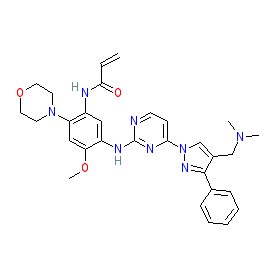GtoPdb is requesting financial support from commercial users. Please see our sustainability page for more information.
|
Synonyms: Compound 73 [WO2016060443A2] | GNS-1480 | GNS1480 | Lazcluze® | Leclaza® | YH-25448 | YH25448
lazertinib is an approved drug
Compound class:
Synthetic organic
Comment: Lazertinib (YH-25448, GNS-1480) is an oral, third-generation inhibitor of the aberrant activity of mutant EGFR kinases (EGFR T790M and the activating EGFR mutations Ex19del and L858R), that was originally developed by Yuhan Corporation for antineoplastic potential in cancers with (acquired) resistance to existing EGFR tyrosine kinase inhibitors [1], in particular for EGFR mutation positive, advanced non-small cell lung cancer (NSCLC). It is claimed in Yuhan's patent WO2016060443A2 as compound 73 [1].
In addition to predicted efficacy for the treatment of primary lung and extracranial lesions, lazertinib is expected to be beneficial for NSCLC brain metastases as it is able to cross the blood brain barrier. Ligand Activity Visualisation ChartsThese are box plot that provide a unique visualisation, summarising all the activity data for a ligand taken from ChEMBL and GtoPdb across multiple targets and species. Click on a plot to see the median, interquartile range, low and high data points. A value of zero indicates that no data are available. A separate chart is created for each target, and where possible the algorithm tries to merge ChEMBL and GtoPdb targets by matching them on name and UniProt accession, for each available species. However, please note that inconsistency in naming of targets may lead to data for the same target being reported across multiple charts. ✖ |
|
|||||||||||||||||||||||||||||||||||
| Bioactivity Comments |
| The inhibitory potency of lazertinib vs. mutant EGFR (Del19, L858R, L858R/T790M and Del19/T790M mutants) in biochemical assays was determined to be <20 nM [1]. In cellular proliferation assays using PC9 and HI975 cancer cell lines, lazertinib was >200-fold selective for these mutant EGFR-containing cells compared to H2073 cells with wild type EGFRs. Lazertinib inhibits JAK3 with a biochemical IC50 of <20 nM, so this should be considered when analysing possible off-target effects. |
| Selectivity at enzymes | |||||||||||||||||||||||||||||||||||||||||||||||||||||||
| Key to terms and symbols | Click column headers to sort | ||||||||||||||||||||||||||||||||||||||||||||||||||||||
|
|||||||||||||||||||||||||||||||||||||||||||||||||||||||
| Selectivity at catalytic receptors | |||||||||||||||||||||||||||||||||||||||||||||||||||||||
| Key to terms and symbols | Click column headers to sort | ||||||||||||||||||||||||||||||||||||||||||||||||||||||
|
|||||||||||||||||||||||||||||||||||||||||||||||||||||||







